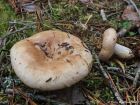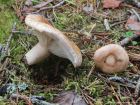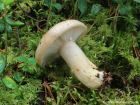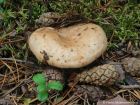Cap initially flattened with a depressed center. It is sticky when young, later becoming almost dry. The edge remains rolled in for a long time. The colour ranges from yellowish-white to pale ochre and sometimes has a faint pinkish tint. The flesh is white to pale yellow and firm. Gills dense, slightly decurrent, white to yellowish-white with a very faint pinkish hue. Stem cylindrical, often hollow, and usually curved at the base. It shares the same colour as the gills and often has a greyish-yellow ring zone near the top, just below the gills. When young, the stem is sticky. Older mushrooms develop light brown spots and often exhibit pits on the stem.
Microscopic Features: Spores are 8-9 x 6.5-7 μm, elliptical to nearly rounded.
Many mushrooms are poisonous, and some can be lethally toxic. Distinguishing between edible and poisonous mushrooms can be very challenging. Therefore, we strongly advise against consuming wild mushrooms. This website does not contain any information about the edibility or toxicity of mushrooms.
Although efforts have been made to ensure accuracy on this website, the information may contain errors and omissions. Therefore, all content provided is for educational and informational purposes only and should not be relied upon or used as a basis for consuming any plants or mushrooms.
External links are provided for reference only. We do not endorse or take responsibility for the content, advice, or products found on these sites or in any advertisements shown on this website.





